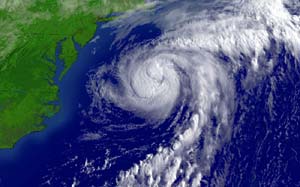| NOAA Magazine || NOAA Home Page || Previous Story |
HURRICANE ALEX ACCELERATING OUT TO SEA
(See
the NOAA National Hurricane Center
for the latest information on this storm. Complete
advisories are posted at 11 a.m., 5 p.m., 11 p.m. and 5 a.m. All
times are Eastern. Advisories are posted more frequently as the
storm nears the USA mainland.) |
 Aug.
4, 2004 — At 11 a.m. EDT, the center of Hurricane Alex was located
near latitude 37.7 north, longitude 69.0 west or about 400 miles east-northeast
of Cape Hatteras, N.C. Alex is moving toward the east-northeast near 20
mph. This motion is expected to continue during the next 24 hours with
a gradual increase in forward speed, according to the NOAA
National Hurricane Center in Miami, Fla. (Click NOAA satellite
image for larger view of Hurricane Alex taken at 8:15 a.m. EDT on Aug.
4, 2004. Click here for high
resolution version, which is a large file. Please credit “NOAA.”)
Aug.
4, 2004 — At 11 a.m. EDT, the center of Hurricane Alex was located
near latitude 37.7 north, longitude 69.0 west or about 400 miles east-northeast
of Cape Hatteras, N.C. Alex is moving toward the east-northeast near 20
mph. This motion is expected to continue during the next 24 hours with
a gradual increase in forward speed, according to the NOAA
National Hurricane Center in Miami, Fla. (Click NOAA satellite
image for larger view of Hurricane Alex taken at 8:15 a.m. EDT on Aug.
4, 2004. Click here for high
resolution version, which is a large file. Please credit “NOAA.”)
![]() Maximum
sustained winds are near 85 mph with higher gusts. Some weakening is forecast
during the next 24 hours.
Maximum
sustained winds are near 85 mph with higher gusts. Some weakening is forecast
during the next 24 hours.
Hurricane force winds extend outward up to 60 miles from the center, and
tropical storm force winds extend outward up to 140 miles. (Click
NOAA image for larger view of Hurricane Alex tracking map.)
Estimated
minimum central pressure is 979 mb, 28.91 inches.
High surf and rip currents
over the mid-Atlantic U.S. coastal area should gradually diminish during
the day on Wednesday.
For storm information specific to your area, please monitor products issued
by NOAA National Weather
Service local forecast offices and statements from local emergency
management officials.
NOAA is dedicated to enhancing economic security and national safety through the prediction and research of weather and climate-related events and providing environmental stewardship of the nationís coastal and marine resources. NOAA is part of the U.S. Department of Commerce.
Relevant
Web Sites
NOAA
National Hurricane Center —
Get the latest advisories here
NOAA
Satellite Services Division — Latest Images
NOAA 3-D Satellite Images
NOAA Enhanced Satellite
Images
NOAA Atlantic Hurricanes
Database — 150 Years of Atlantic Hurricanes
Above-normal
2004 Atlantic Hurricane Season Predicted
Saffir-Simpson Hurricane
Scale
NOAA Flood Products
NOAA
Inland Flooding Information
Significant
River Flood Outlook
NOAA Rainfall Graphics
24-hour
Observed Precipitation as of 8 a.m. today
Latest
rainfall data as of 8 a.m. EDT today
NOAA Buoys
NOAA
Tides Online
NOAA Satellite Images — The
latest satellite views
Colorized Satellite Images
NOAA Hurricanes Page
NOAA Storm Watch —
Get the latest severe weather information across the USA
Media
Contact:
Frank Lepore, NOAA
Hurricane Center, (305) 229-4404